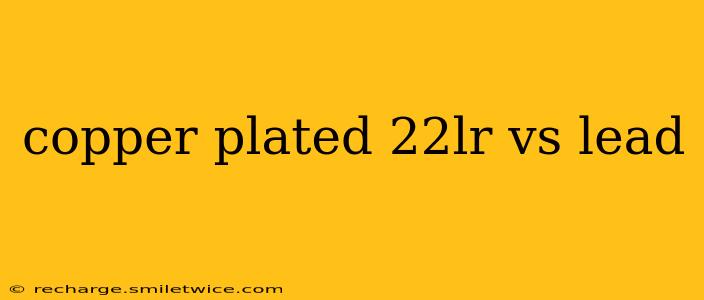Copper Plated vs. Lead 22LR: A Detailed Comparison for Shooters
The .22 Long Rifle (22LR) cartridge is a ubiquitous round, popular for target shooting, small game hunting, and plinking. A key point of variation among 22LR cartridges lies in the bullet's composition: lead versus copper-plated. While both achieve similar results at close range, understanding their differences is crucial for selecting the right ammunition for your specific needs. This article will delve into the pros and cons of each, addressing common questions surrounding these popular choices.
What is the difference between copper-plated and lead 22LR ammo?
The primary difference is the bullet's jacket. Lead 22LR rounds utilize a pure lead core. Copper-plated rounds have a lead core encased in a thin layer of copper or copper alloy. This seemingly small difference impacts several aspects of performance and handling.
How does the copper plating affect accuracy?
Accuracy: While many shooters perceive copper-plated ammunition as more accurate, it's not universally true. Both lead and copper-plated rounds can offer high accuracy depending on the manufacturer and the quality of the ammunition. The copper plating can help with cleaner feeding in some firearms due to its slightly harder surface, leading to improved consistency and potentially better accuracy. However, the accuracy ultimately depends on several other factors, including the firearm's condition, the shooter's skill, and environmental conditions.
What about the impact on cleaning?
Cleaning: This is where copper-plated ammunition shines. Lead leaves significantly more residue in the barrel, requiring more frequent and thorough cleaning. The copper plating reduces lead fouling, simplifying maintenance and prolonging the lifespan of your firearm. For those who shoot frequently, this is a significant advantage.
Which is better for hunting small game?
Small Game Hunting: For small game hunting, both work effectively at close ranges. The impact on the game is similar. However, the reduced fouling from copper-plated ammunition can be beneficial if you're shooting a lot during a hunting trip, allowing you to spend less time cleaning and more time hunting.
How does the price compare?
Price: Generally, copper-plated 22LR ammunition is slightly more expensive than lead-round ammunition. However, the reduced cleaning time and potentially longer firearm lifespan can offset the higher initial cost over the long term.
Is one type better for target shooting?
Target Shooting: For target shooting, the choice between copper-plated and lead ammunition often comes down to personal preference. Both can deliver excellent accuracy. However, the cleaner burning of copper-plated rounds can make them preferable for those who value easy maintenance.
Which is better for plinking?
Plinking: For informal plinking, cost-effectiveness often dictates the choice. Lead 22LR rounds are usually more affordable and perfectly adequate for casual shooting. However, if reduced cleaning is a priority, copper-plated rounds are a worthwhile investment, even for plinking.
Are there environmental concerns?
Environmental Concerns: Lead is a toxic heavy metal. While the amount of lead in a single 22LR round is relatively small, the cumulative impact of millions of discarded lead bullets on the environment is a genuine concern. Copper is less toxic, making copper-plated ammunition a more environmentally friendly option.
In conclusion, the "best" choice between copper-plated and lead 22LR ammunition depends on individual needs and priorities. Consider the factors discussed above – accuracy needs, cleaning frequency preferences, hunting vs. plinking, budget, and environmental impact – to make an informed decision. Both types of ammunition are reliable and suitable for various applications, allowing you to choose the option that best fits your shooting style and circumstances.
